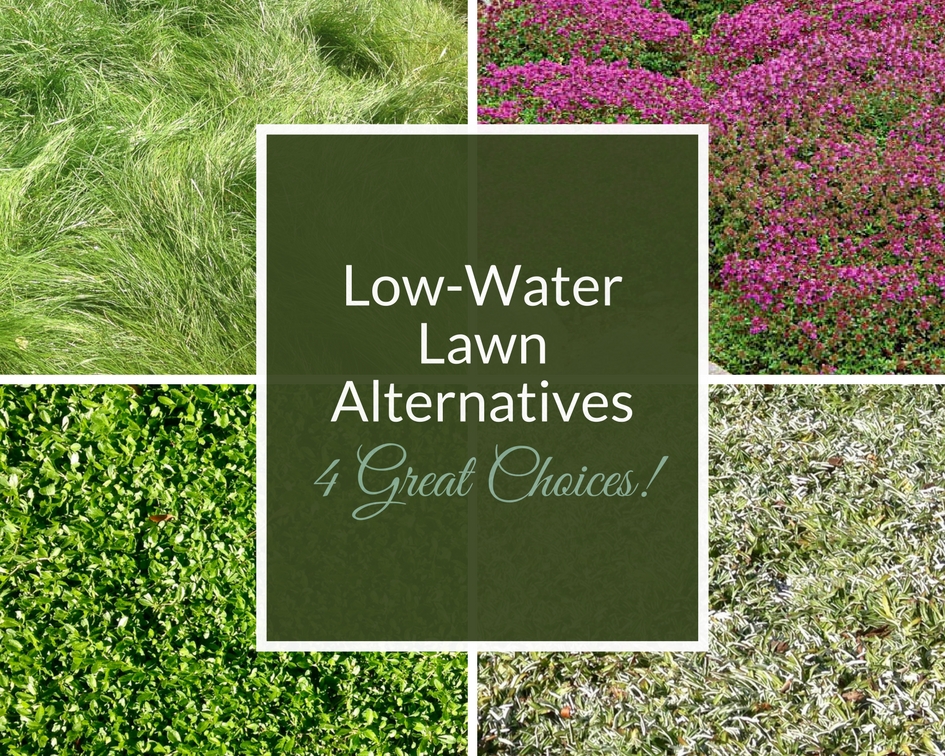
California homeowners realize that a verdant green lawn requiring large amounts of water is no longer an environmentally responsible option. Many people still want some sort of “lawn-like” area but how to achieve that look without using so much water?
Here are four great water-wise plant alternatives you can use to replace your lawn and reduce the amount of water you use.
NATIVE GRASS SOD
Lawn Alternative #1
There are two great sod alternatives that use native grasses that are highly drought tolerant. Both can be left unmowed for a meadow-like look or mowed more frequently for a traditional lawn look. Both varieties, once established, will require half the amount of water as a typical lawn. When used as either a meadow-like lawn or a more traditional lawn, both can withstand light foot traffic. Both are available in rolls, like traditional sod, from Delta Bluegrass Company.
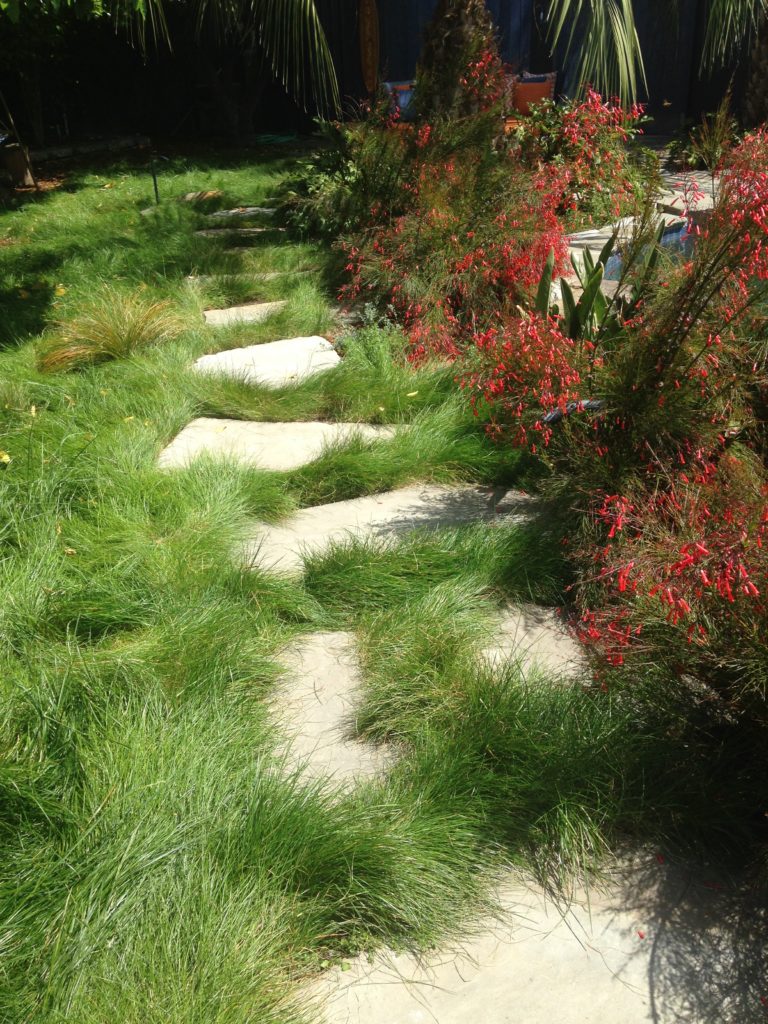
I love the green “waves” of this meadow-like Native Mow Free™ lawn! (Garden Design by Laura Morton Design)
Native Mow Free™ is a blend of three native grasses that have fine, deep green blades and can be used as a lawn replacement or as a groundcover for slopped or steep areas. This blend is very shade tolerant. It can be grown in areas with up to 50% shade as well as in full sun. It can be left long for a meadow-like look or kept short as a more traditional lawn. If you want to use the Native Mow Free™ as a traditional lawn, cut it no shorter than 4”.
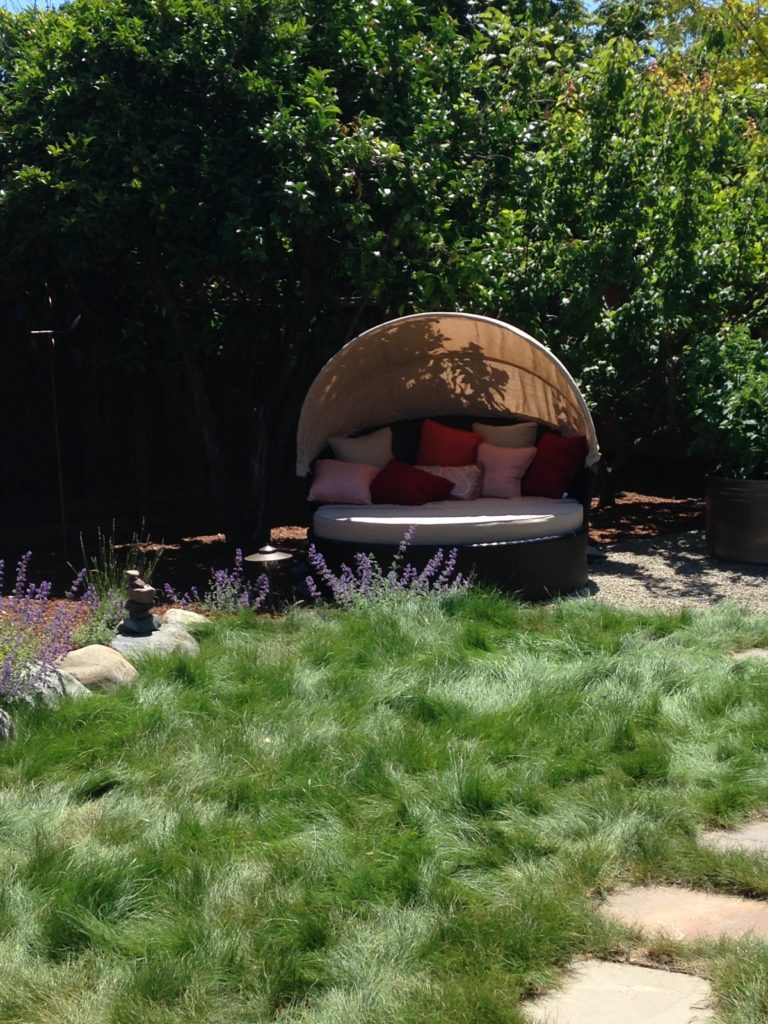
This meadow-like lawn adds a wonderful textural element to the garden. (Garden Designer unknown)
The other native sod grass is Native Bentgrass™ and it has a medium-sized leaf blade. This variety can be left long for a meadow look or kept short – 2″ to 3” high – for a more traditional lawn look. It does best in full sun to part shade.
I love using these native sods as a lawn replacement by leaving the grass long so the 10 – 12” blades flop over creating undulating, green “waves.” Learn more about how I used Native Mow Free™ sod to replace a traditional lawn in a landscape design project I did in Cupertino .
THYME
Lawn Alternative #2
Thyme is a drought-tolerant groundcover you can use to replace a small lawn. This low-growing, creeping plant is commonly used in between flagstone stepping stones, but it is vigorous enough that it will rapidly fill in an entire area. It has teeny olive-green leaves and will be covered with small flowers in the summer. It can tolerate light foot traffic once it is established, and as you walk on it, the foliage releases its terrific fragrance! Thyme likes full sun, warm temperatures, and well-drained soil. Once established, it requires little water and no mowing.
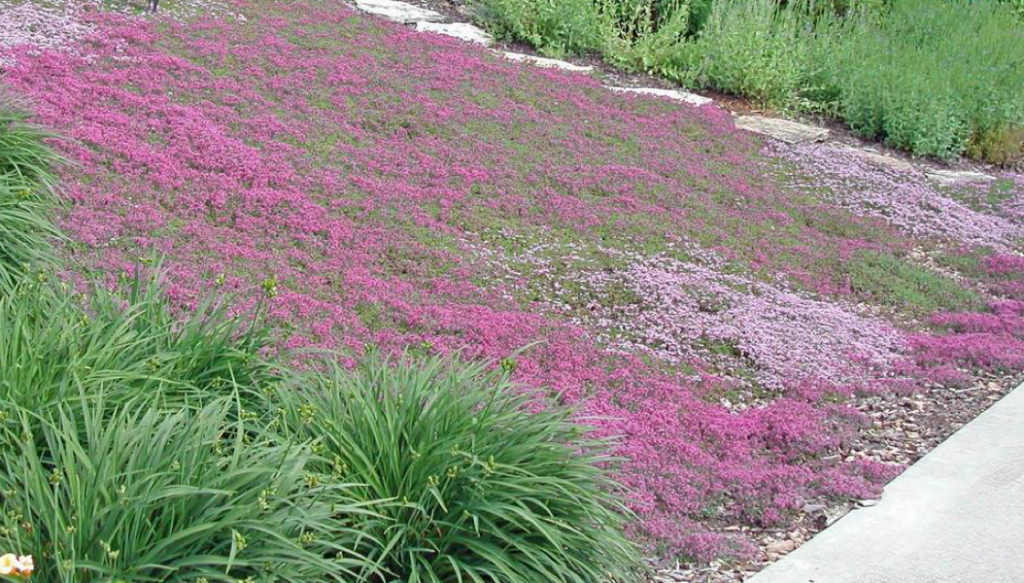
A mixture of several different types of Thyme creates a drought-tolerant lawn substitute.
There are many different varieties of Thyme you could use as your “stepable” groundcover with different flower colors. Select just one or combine several together. You can even put Culinary Thyme (Thymus vulgaris) and/or Variegated Lemon Thyme (Thymus x citriodorus ‘Variegata’), which are taller varieties, along the edges. Here are a few good choices for a lawn replacement, but feel free to experiment!
- Elfin Thyme (Thymus serphyllum) – lovely lavender pink flowers
- White Elfin Thyme (Thymus serphyllum ‘Albus’) – little white flowers
- Bressingham Thyme (Thymus doerfleri ‘Bressingham’) – dusty-pink flowers
- Red Creeping Thyme (Thymus praecox ‘Coccineus’) – spectacular magenta pink flowers
- Wooly Thyme (Thymus pseudolanuginosus) – light pink flowers
Thyme is not available as rolls, so instead you purchase it in flats and then separate it into pieces, and plant them about 6 – 8” apart. During its first season, put a layer of mulch in the “blank” areas to keep the soil moist and inhibit weed growth. Once established (give it regular water during the first six months), it then becomes extremely drought tolerant.
KURAPIA
Lawn Alternative #3
This is my new favorite groundcover! This drought-tolerant lawn alternative can use up to 60% less water than traditional turf grass. (Yep, that’s 60%!) It has a very tight and dense growth habit reaching only 1 – 3” high, making mowing optional. It can be grown in full sun to part shade and can withstand light foot traffic. From May to November it has small white flowers. It can be irrigated using high-efficiency sprinklers or underground drip irrigation.
This is an incredibly versatile groundcover. I’ve used Kurapia as a lawn alternative in a small, simple garden for its clean, tidy look.
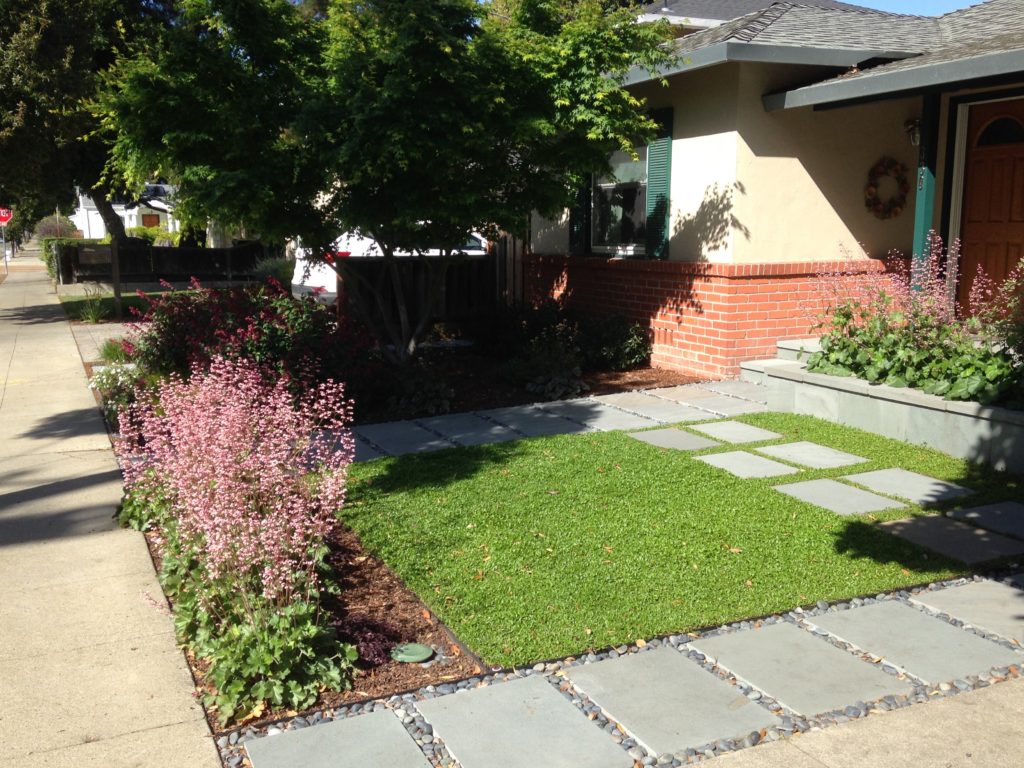
This Kurapia “lawn” looks great with the clean, straight lines of the rectangular concrete stepping stone pathways. (Garden Design by Vision Garden Design)
And, it is equally at home in a more informal garden as a lawn replacement with flagstone stepping stones.
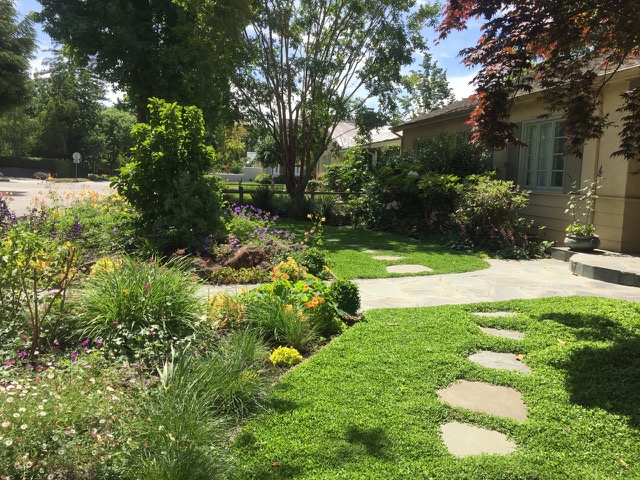
A great example of a Kurapia “lawn” with a flagstone stepping stone pathway. (Garden Design by Heaven & Earth Landscape Design)
I’ve seen it used in parking strips because it can tolerate hot and dry conditions. And, it can also be used as moss “look-alike” groundcover in between plants. Kurapia is available in sod rolls from Delta Bluegrass Company.
DYMONDIA
Lawn Alternative #4
Dymondia margaretae or Silver Carpet is a great low-growing groundcover you can use as a lawn replacement. This plant has beautiful silvery, olive-green foliage with dainty yellow flowers in summer. Silver Carpet can only tolerate light foot traffic, so in higher traffic areas, you will want to use stepping stones to create a pathway.
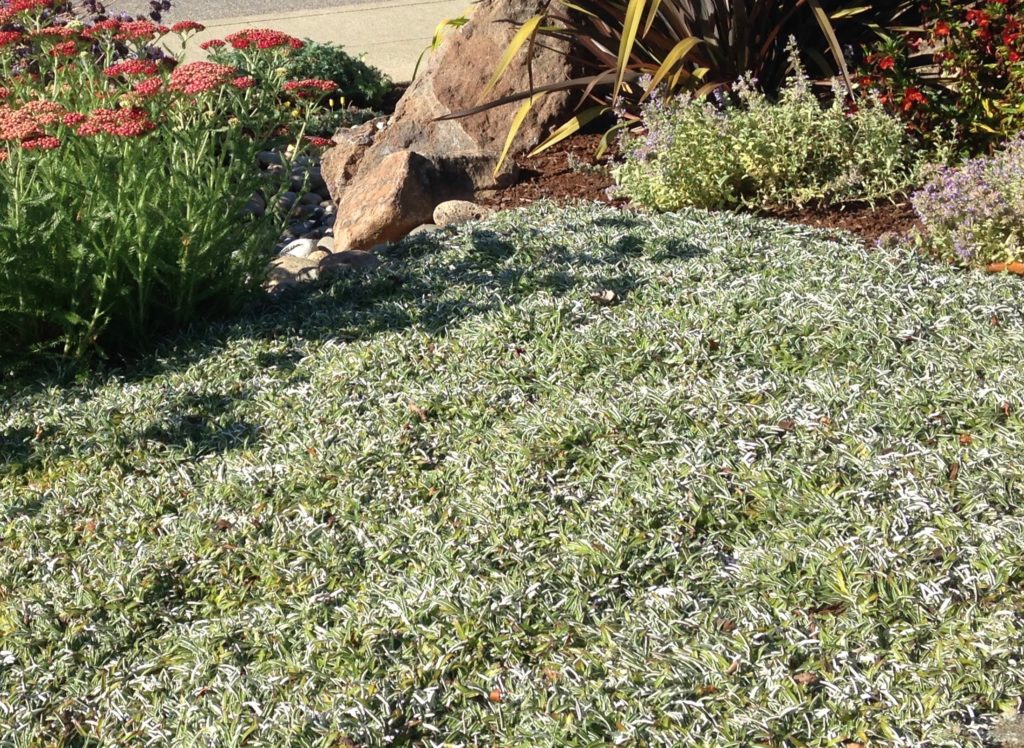
A fantastic Silver Carpet Dymondia “lawn” approximately nine months after installation.
Dymondia requires full sun and does best in warm temperatures with well-drained soil. Because this plant is not available as rolls, you purchase it in flats, divide it into pieces, and plant them about 12” apart (it fills in faster than Thyme). To keep the soil moist and inhibit weed growth as the Silver Carpet fills in, spread a layer of mulch in the “blank” areas. Once established (give it regular water during the first six months), it then becomes extremely drought tolerant. This lawn-replacement will never require mowing. It may take a season for the Dymondia to completely fill-in the area, but it is well worth the wait!
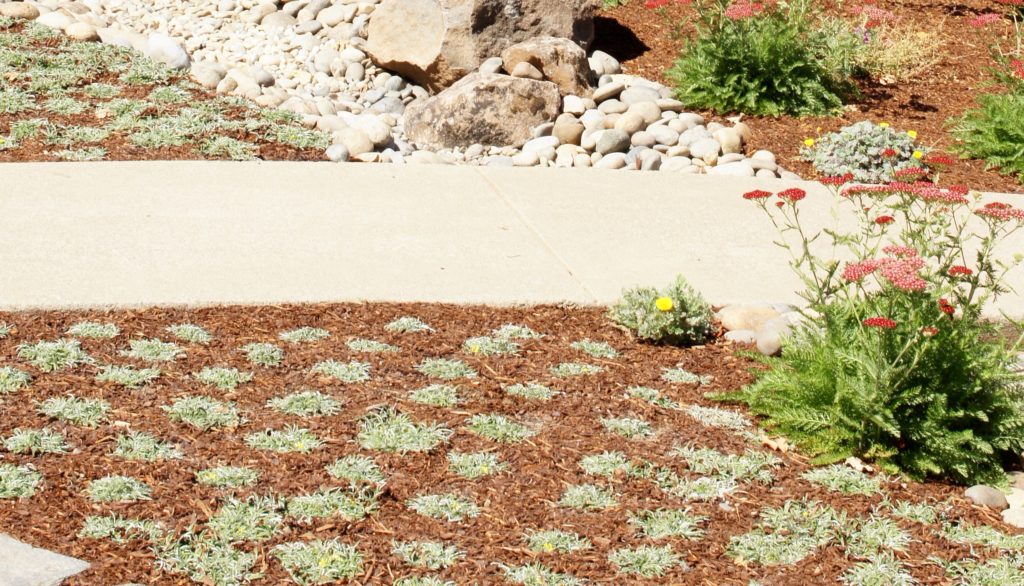
How a newly installed Dymondia “lawn” will look.
To see an example of a project where I used Silver Carpet, check out “From Front Lawn to Sustainable Beauty.” In this Mountain View project, the thirsty lawn was removed and Dymondia was used as a beautiful lawn replacement. I combined it with a mixture of California native and Mediterranean climate plants to create a vibrant drought-tolerant garden.
Want help changing your yard to a low-water garden?
If you live in the San Francisco or Monterey Bay Areas and are looking to transform your yard to a low-water garden including replacing your traditional lawn with a low-maintenance, drought-tolerant lawn alternative, please contact me for a 30-minute complimentary design consultation. You can schedule a call by clicking here.
SHARE